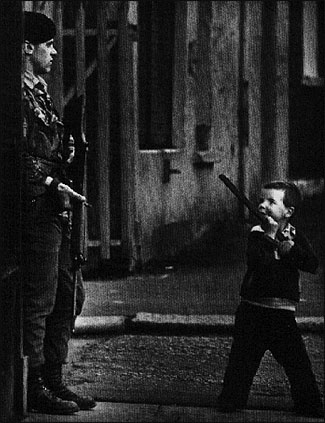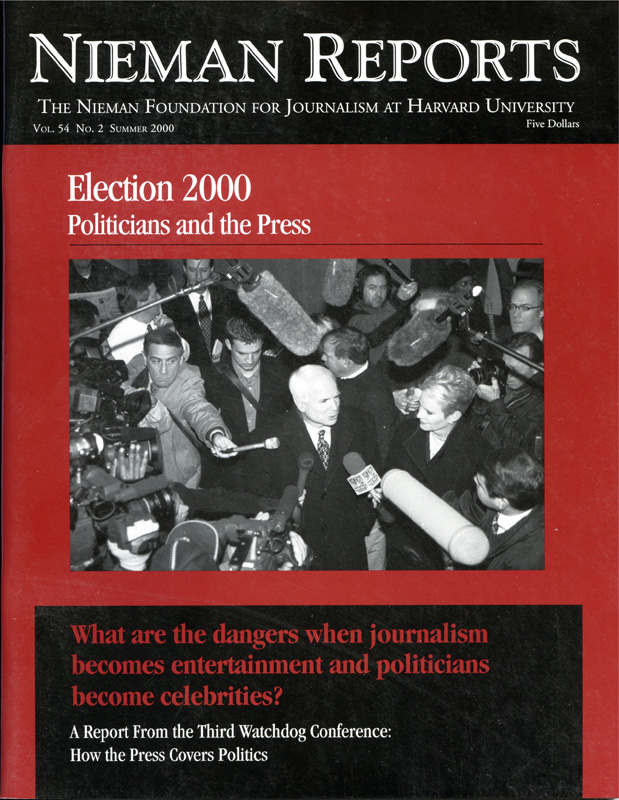
A child points a stick gun at a British soldier in Belfast, Northern Ireland. Photo by Stan Grossfeld, courtesy of Grossfeld/The Boston Globe.
Television detonated “the Troubles” in Northern Ireland. Inherently unstable because of competing British and Irish nationalisms, the state was political nitroglycerine anyway. When television jolted it, the mix exploded.
Three episodes televised during the 1960’s were seminal.
The first came from America. When television news of the black civil rights campaign gripped viewers throughout Europe, the Northern Ireland Civil Rights Association (NICRA) copied in detail the protest tactics of Martin Luther King, Jr. to highlight injustice. The second episode occurred in the Republic of Ireland, when Irish state television (RTE) broadcast passionately patriotic celebrations of the 50th anniversary of the 1916 Easter Rising which had led to political independence from Britain for the 26-county state. The third involved RTE footage of Royal Ulster Constabulary (RUC) policemen attacking civil rights marchers in Derry in October 1968.
Such was the transforming power of moving pictures that these images did what words alone had not.
In Northern Ireland, the media’s entangled roles of observer and player have been easy to recognize but more difficult to unravel. Like the conflict itself, it’s essentially a matter of competing contexts. (Irish nationalists are a minority within Northern Ireland but a majority on the island of Ireland.) The intricacies of the media knot bewilder most observers. During the last 30 years, British media, print and electronic, have been the most influential in shaping world opinion. For the most part, these have, not surprisingly, sought to cast Britain as an honest broker rather than a combatant in the dispute. However, liberal sections of the British media have frequently been more forthright than have most mainstream Irish media in challenging this position.
The more conservative British broadsheets, The Times and the Daily Telegraph, the mid-market papers, The Mail and The Express as well as Fleet Street’s notorious “red-top” tabloids have cast the conflict in the starkest terms as simply a war against unprovoked terrorism. On the other hand, The Guardian and a number of groundbreaking investigative TV documentaries (from both the BBC and commercial TV in Britain) have consistently sought to portray all sides of the conflict. None, of course, has condoned political violence but the existence of institutionalized injustice has been acknowledged.
Through the combination of naiveté (RTE’s 50th anniversary of 1916) and duty (televised news of civil rights marchers being attacked in America and Derry), the media—most noticeably television in the Republic of Ireland—accelerated the onset of the Troubles. However, this all happened before a resurgent IRA went on the offensive in Northern Ireland in the early 1970’s. Since then, the dominant concern for most mainstream media in the Republic (RTE, The Independent Group of newspapers and The Irish Times, the influential organ of liberal bourgeois Ireland) has been to protect the integrity and international standing of the 26-county state. This has resulted in trenchant and repeated condemnation of all paramilitary groups, not least the IRA, and broad-based support for the constitutional Irish nationalists of John Hume’s Social Democratic and Labour Party (SDLP). At times, Ireland’s best-selling newspaper, the Sunday Independent—liberal in its portrayal of social policy, conservative when it comes to economic policy, and celebratory of the “good life” in its vibrant coverage of sex, glamour and wealth—has supported the unionist position even ahead of the moderate SDLP’s.
Perhaps what is most difficult for American journalists to understand is the culture of media censorship in Ireland and Britain, which has had an impact on the kind of coverage “the Troubles” have received. With no equivalent of the U.S. Constitution’s First Amendment, censorship is routine. During several decades of coverage of the conflict in Northern Ireland, government censorship, by the standards of the Western democracies, has been draconian. Between 1974 and 1994, Section 31 of the Republic’s Broadcasting Act banned a number of organizations from appearing on radio and television. These banned groups included Sinn Fein, the political wing of the broader republican movement that also includes the IRA.
Supporters of the ban (among them most of the major Irish and British newspapers) claimed that militant republicans were fascists out to subvert not just Northern Ireland but the Republic also, and therefore censorship was justified. Opponents argued that such demonizing of republicans allowed them to avoid facing up publicly to atrocities, thereby prolonging the conflict. Furthermore, opponents insisted, the ban was patronizing and anti-democratic since it assumed that the license-fee payers (all those who own a television set must pay a fee to support the state broadcaster) who funded RTE would be incapable of recognizing and resisting propaganda. Others charged that state censorship is inevitably a form of state propaganda.
The stated position of the National Union of Journalists in Ireland was against Section 31. But the union’s broadcasting branch at RTE implemented the ban with an alarming meekness that struck many journalists as being suspiciously close to support for it. Section 31, though it has not been activated since 1994, remains as the deepest ideological fault line among Irish journalists. European journalists, fearing the dangers inherent in the principle of state censorship, regularly lobbied for its removal.
It’s impossible to know if Section 31 saved lives or caused them to be lost by prolonging the conflict. But it is certain that American journalists would not have put up with it. It must be understood that, unlike America, Britain is a very hierarchical state, still dispensing feudal titles. Because of the monarchy, there is no such creature as a British citizen. British people are subjects of the crown. By contemporary Western standards, Britain is a secretive society and its media are tightly controlled by law. In the Republic of Ireland, although its people are citizens not subjects, the legal climate remains strongly influenced by the paternalism prevailing in Britain. So Section 31 in Ireland and similar legislation in Britain made reporting the conflict unduly difficult.
At the core of all arguments resides the notoriously thorny question of the right of states to censor versus the right of individuals to know. Equally problematic in ethical terms has been the fact that violence has generated the preponderance of international media attention in the North. Given the nature of news, that, of course, is not surprising. But it has inevitably distorted world opinion. For example, even though the conflict has produced appalling acts of mass murder, fewer people have been killed by political violence than in automobile accidents in Northern Ireland during the last 30 years.
Yet in an ever more connected global environment, the international context of the conflict will ultimately be the determining one. For that reason, the propaganda war has been recognized by the contending parties in Northern Ireland to be of the utmost importance. Although fully aware of this perspective, even the most prestigious and influential media organizations rarely acknowledge, and even less often tackle, this reality. Indeed, instead of attempting to offer a sufficiently thorough analysis, commentators characteristically resort to expressions of exasperation and bewilderment each time an attempted political solution fails.
There’s bitter irony in the fact that conventional media narratives of good guys and bad guys do not make comprehensible the core problems of Northern Ireland. Deep forces, defying reason and motivated by volatile instinct, mean that for Catholic republicans and Protestant monarchists, the soul of “the Troubles” is really about sovereignty of identity—the right to believe you are right to believe what you believe. Such metaphysical concerns or understandings are not the currency of the media, many aspects of which are actively hostile to absorbing such abstractions.
But not all ironies are bitter. Some, in fact, are deliciously sweet. In spite of the Irish, British and international contexts in which the media have addressed the conflict, some of the most hopeful signs are emanating from within Northern Ireland’s own media. There, the pro-British News Letter and the pro- Irish Irish News last year published joint editorials endorsing the peace process. If opponents can empathize with each other’s difficulties, then there’s always hope that concern for the common good will prevail over the claims of competing sovereignties.
Still, attitudes towards American intervention and the American media are salutary. Generally, unionists decry U.S. involvement because from their perspective the problems of Northern Ireland are an internal matter for the government of the United Kingdom. It’s a view that emphasizes the legitimacy, moral and legal, of a sovereign state. Irish nationalists, on the other hand, tend to welcome American involvement. They are also invariably quick to remind Americans that as citizens of a republic, which used force to usurp the British crown, opposing Irish republicanism is ideological hypocrisy. It’s a view that puts emphasis on the moral legitimacy of the individual and of popular sovereignty. In the event of a British withdrawal and a united Ireland, many among the contending parties could well just swap justifications. Northern Ireland is like that. Reason doesn’t always rule.
While violence raged, the media organizations of Ireland, Britain and the international community quite rightly engaged primarily in reporting. Now that there is a peace, albeit an uneasy peace since the suspension of the power-sharing executive, Northern Ireland has slipped down on the world’s news agenda. To some, it must seem as though a true solution will never be found, and anyway there are fresher, more violent conflicts to cover.
Because of certain irreconcilable contexts surrounding this conflict (such as the mix of population in Northern Ireland, its historic connections to the Republic of Ireland as well as Britain, its proximity to Europe, and its global context), it’s always possible that there might be a fatal, potentially catastrophic flaw at the heart of Northern Ireland. But there’s certainly a flaw in media that refuse to let their reporting of this story evolve. The narrative of heroes and villains cannot explain this conflict. What is needed now are journalists who understand well what has ignited the passions of these people and who will move out from their parochial positions to examine what lies at the core of the intense emotions that travel across the popular divides. Without this kind of storytelling, sadly the stories of violence and hatred that have dominated news from the North for so many years might return again to the front pages and nightly newscasts. One thing we’ve all learned during coverage of “the Troubles” is that the mix of media and Northern Ireland can produce both explosions and explanations.
After an era of explosiveness, it’s time for explanations.
Eddie Holt is a lecturer in the School of Communications at Dublin City University and Television Critic of The Irish Times.


